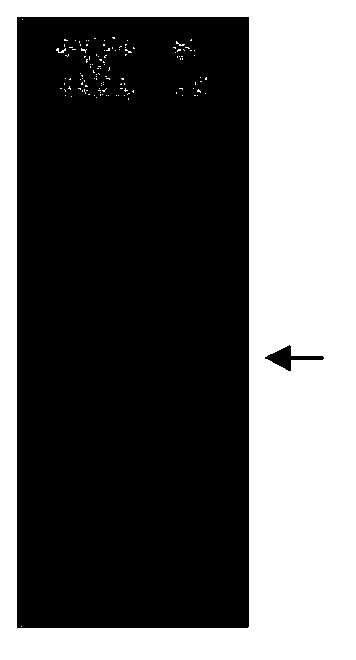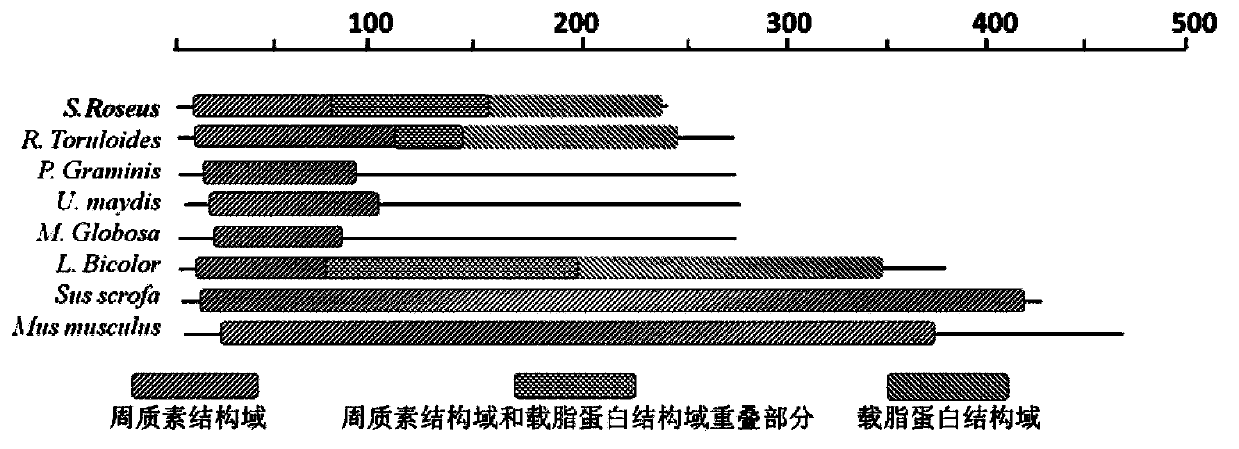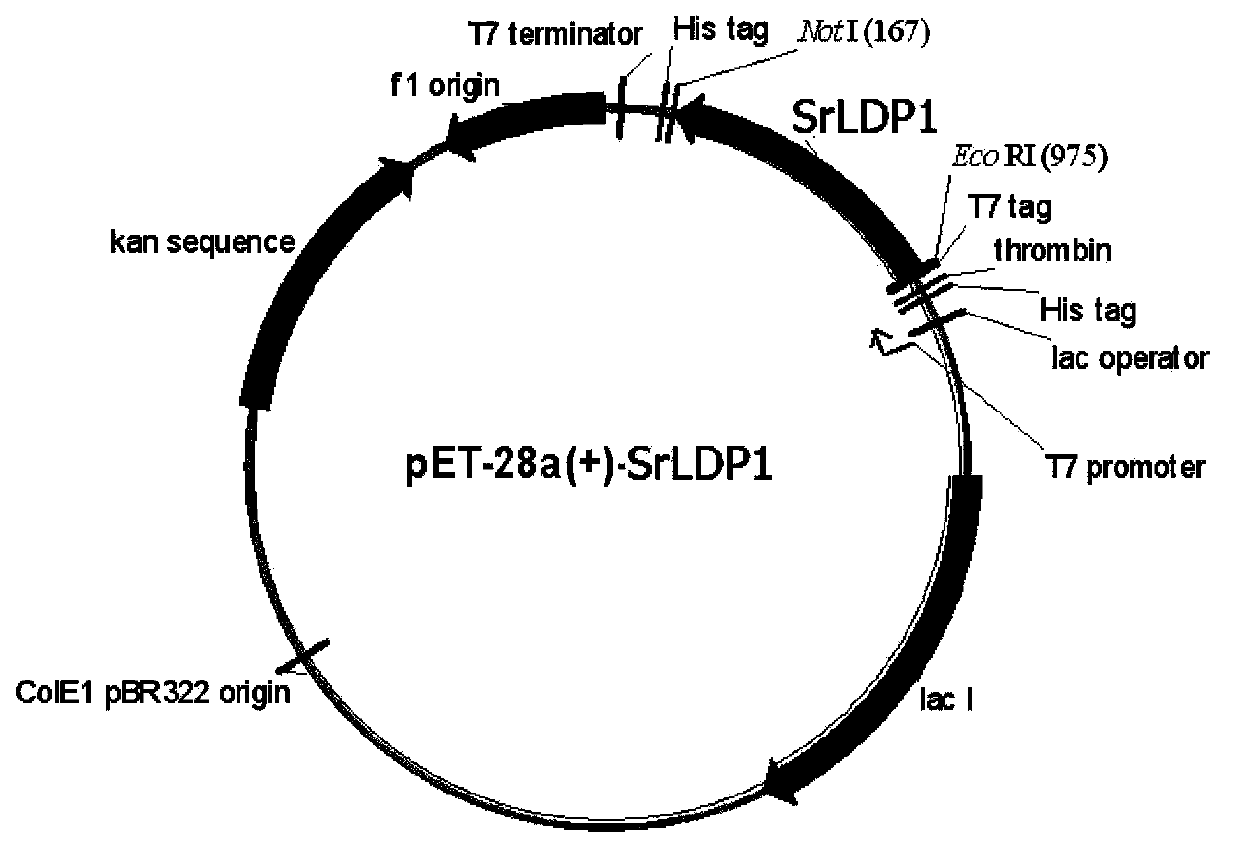S.roseus lipid droplet protein 1, coding gene and application thereof
A yeast lipid and protein technology, applied in the fields of application, genetic engineering, plant genetic improvement, etc., can solve the problem of increasing the oil content of recombinant strains, and achieve the effect of improving the stability of lipid droplets and increasing the oil content
- Summary
- Abstract
- Description
- Claims
- Application Information
AI Technical Summary
Problems solved by technology
Method used
Image
Examples
Embodiment 1
[0059] Example 1: Discovery of Saccharomyces spp. perilipin-like protein
[0060] S. roseus JCM8242 was cultured in liquid YEPD medium at 30°C for 36h. The wet cells were collected by centrifugation, washed twice with distilled water, and stored in a -80°C refrigerator for RNA and protein extraction. The same cultured samples (parallel samples) were used to determine the dry cell weight and oil content. Sample named 'YEPD'.
[0061] S. roseus JCM8242 was fermented on nitrogen-limited medium to achieve oil accumulation. It is carried out in a FUS-15L bioreactor with a liquid volume of 8L, an inoculum volume of 10%, a temperature of 30°C, an aeration rate of 0.8vvm, and dissolved oxygen controlled at 40-50% saturation value (dissolved oxygen and stirring linkage). The pH was automatically controlled at 5.6 by dropwise addition of 10.0M NaOH and 2M HCl. Take out 50mL of cell culture fluid cultured for 24h and 96h respectively, and the samples are named '24h' and '96h' respect...
Embodiment 2
[0085] Embodiment 2: the cloning of srldp1 gene of sporogenous yeast
[0086] According to the amino acid sequence of SrLDP1, degenerate primers were designed:
[0087] srldp1-sence: ATGGARCARACNTTYCC (N: A / C / G / T, R: A / G, Y: C / T)
[0088] srldp1-anti: TTAYTCNGAYTTNGTCGT (N: A / C / G / T, Y: C / T) ( / stands for "or")
[0089] The primers were all in the 5' to 3' direction.
[0090] S. roseus JCM8242 total RNA was extracted by liquid nitrogen grinding plus RNAiso method [Yang F, Tan HD, Zhou YJ, Lin XP, Zhang SF.Mol.Biotechnol.2010, 47(2), 144-151]. The RNA was subjected to 1.5% agarose gel electrophoresis, observed and identified using a fluorescence-ultraviolet analyzer, and two clear bands could be seen. Analyze the total RNA sample with a UV / Vis spectrometer and measure the OD 260 / 280 =2.0, indicating good quality of total RNA. Total RNA samples were stored frozen at -80°C for later use.
[0091] First-strand cDNA was synthesized using High Fidelity PrimeScript RT-PCR Kit (p...
Embodiment 3
[0093] Example 3: Prokaryotic expression and protein purification of the sporozoan srldp1 gene
[0094] According to the nucleotide sequence of srldp1, the primers with corresponding restriction sites were designed (the underlined part of primer srldp1-EcoRI-F is the EcoRI restriction site, and the underlined part of primer srldp1-NotI-R is the NotI restriction site), The sequence is as follows:
[0095] srldp1-EcoRI-F:G GAATTC ATGGAACAAACTTTCCCCGCCACC
[0096] srldp1-NotI-R: AAAAGGAAAA GCGGCCGC TTAGTCGGAGTTCGTCGTCTCTTTT
[0097] The primers were all in the 5' to 3' direction.
[0098]Using the cloning vector pMD18T-srldp1 constructed in Example 2 as a template, use the primers srldp1-EcoRI-F and srldp1-NotI-R to amplify the sequence of the srldp1 coding region. The pET28a vector (recovering large fragments for ligation reaction) was transformed into E.coli DH5a chemically competent cells, and the correctly constructed recombinant plasmid was named pET28a-srldp1 ( ima...
PUM
| Property | Measurement | Unit |
|---|---|---|
| Molecular weight | aaaaa | aaaaa |
| Theoretical molecular weight | aaaaa | aaaaa |
Abstract
Description
Claims
Application Information
 Login to View More
Login to View More - R&D
- Intellectual Property
- Life Sciences
- Materials
- Tech Scout
- Unparalleled Data Quality
- Higher Quality Content
- 60% Fewer Hallucinations
Browse by: Latest US Patents, China's latest patents, Technical Efficacy Thesaurus, Application Domain, Technology Topic, Popular Technical Reports.
© 2025 PatSnap. All rights reserved.Legal|Privacy policy|Modern Slavery Act Transparency Statement|Sitemap|About US| Contact US: help@patsnap.com



